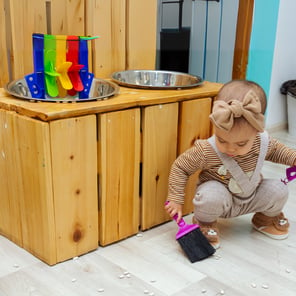Kid-Friendly Organization: Teaching Tidy Habits Early
Strategies, tips, and products for curating dedicated spaces for children and encouraging independence in responsibilities.
.png?width=575&height=324&name=Blog%20Headers%20(5).png)
Teaching children to stay organized is a gift that keeps on giving (can I get some snaps?). It builds independence, a sense of responsibility, and confidence. Keeping in mind that every child is unique, each with their strengths, preferences, and challenges, so creating systems that work for them is the key to success. This blog explores inclusive and practical strategies to help children of all abilities develop crucial habits.

1. Dedicated Kid Spaces
Children are more likely to engage with organization, when their spaces are designed for them. Their size, interests, capabilities and more need to be taken into account. Children need to feel comfortable in their dedicated space.
- Child-friendly storage: Opt for open or see-through bins and adjustable (low-enough) shelves. Rather than using wording in labels, opt for labels or stickers with pictures. Pictures are especially helpful for children who are visual learners or children with developmental delays.
- Color-coded systems: Assign their favorite colors to toys, books, school supplies, drawers, etc. to make storing and finding, easier. This system supports children with cognitive differences by simplifying categorization.
- Create zones: Dedicated spaces! You could use a curtain or room divider to divide rooms into designated areas. Like, a reading corner, arts station, play zone, sensory-friendly, etc. If you have a little one, you could consider something like this divider to help create those spaces, even if on a smaller scale.
2. Teaching Habits Through Play
Organization can feel overwhelming for adults. Let alone children. When paired with play, it becomes not-so-scary and intense. Finding ways to make it fun or incorporate a game, works 9/10 times! Right?
- Clean up = game time: Using timers is an easy way to turn a quick toy clean-up into a fun race! This is where taking the steps of teaching them where things go, what pieces go together, a clean-up race can actually be super fun (bonus: and a great way to get a little exercise in if you're cleaning with them). You can try this timer if your kiddo prefers visual timers! You could even turn something like these chore sticks into a game!
- Visual Schedules/Charts: A great way to introduce chores! Kids love feeling independent, especially after learning new skills. Picture charts or step-by-step guides can help children visualize and process what to expect and are especially helpful for neurodiverse children thriving with structure.
- Use storytime to teach: There are many helpful all-levels kids' books out there created to help your child learn about organization, responsibility, tidy habits, and decluttering in a fun way that matches where they are developmentally. Here are a few: A Place for Everything, Cami Kangaroo Has Too Much Stuff, The Berenstain Bears and The Messy Room.
.png?width=296&height=296&name=for%20blogs%20(1).png)
3. Celebrate Small Progress, Take it at Their Place
As an adult, it's hard to keep my room tidy all the time, let alone my child (LOL). When they're learning these new skill sets, it's important to take it day by day and still give encouragement for the small wins. Maybe they've placed their shoe just outside the bin, but hey, it's not in the fridge so, WIN!
- Start with small tasks: Starting with tasks like putting away shoes, picking up dirty clothes and putting them in the hamper, or putting back all their blocks in the bag is a GREAT start. They're familiar with these items, they touch/play with them every day. Enforcing a routine in bursts, starting with the small tasks, will help through repetition.
- Implementing a reward system: Positive reinforcement does wonders for a child's self-esteem and progress. It encourages consistency. You know how your kiddo likes to be rewarded, but here are a few things we recommend trying: the Melissa & Doug Chart and a Magnetic Responsibility Reward Board.
.png?width=294&height=294&name=a%20kid%20trying%20to%20clean%20up%20mess%20(2).png) 4. Predictable Routines
4. Predictable Routines
Consistency. is. KEY.
- Set clear expectations: Using phrases like “Toys go in this bin before bedtime” or “Books go on the shelf after reading.” while physically pointing to what you're talking about is wonderful. Some kiddos may need a little bit of extra time and reinforcement but truly, consistency is everything.
- Add in organization with existing routines: For example, if a shower after dinner is a part of the routine, add in a shower toy clean up afterward.
- Adjust for sensory needs: If a child finds certain textures, sounds, or clutter levels overwhelming, adapt the routine. For instance, noise-canceling headphones or dimly lit spaces can create a calming environment for tasks like tidying and organizing, here are some LED dimmable bulbs you can swap out for.
5. Making Organization Accessible for All Abilities
Every child deserves systems custom to their unique strengths, challenges, and skill level.
- Sensory-friendly: For kids with sensory processing differences, using soft storage, muted colors, clear bins, or simplified steps/charts helps meet them where they are. The important thing is that your child feels seen through THEIR lens. Here's a great toy storage solution that accommodates the clear and softer-storage needs.
- Use adaptive tools: If a child has limited mobility, consider storage solutions that can be customized, or can sit vertically or horizontally, like this cubby shelf. Finding creative ways to work with your child's ability doesn't have to be a solo mission. Ask your child what works best for them! You can try deeper drawers, and even redoing the closet as a horizontal storage space rather than vertical.
- Break up tasks into small steps: Multiple-step instructions can be overwhelming. Simplifying tasks into smaller, easily-achievable actions, such as “Pick up one toy and put it in this bin." encourages them to keep going, not to mention checking off tasks just gives that seratonin boost we want.
- Collaborate with your community: Occupational or behavioral therapists can provide additional personalized strategies for creating dedicated spaces and achievable routines. The same goes for online forums and groups. Lean on the community of parents who tried all these techniques! There's power in knowledge, support, and experience.
 6. Talk to Them!
6. Talk to Them!
Acknowledging success is just as important as acknowledging effort and failures. Ask them questions like "How does your room feel?" "Would you like to move this somewhere else?" Encourage them to be apart of the conversation and decision-making, they'll feel more ownership and proud in their progress!
Showing the impact of their effort by pointing out how much more functional or tidy space is now because of them and their effort helps associate their work with positive emotions! Nothing in the world can stop a motivated child.
Conclusion
Teaching children to be organized doesn’t happen overnight, but with thoughtful strategies and inclusive systems, you can help your child develop skills that serve them for life. Remember to be patient not only with your child but also with yourself. Finding the perfect systems don't happen easily and they are certainly curated to your specific little one. What works for someone may not work for you.
Create functional, accessible spaces while fostering independence and a sense of pride and ownership in your child's environment. Stay flexible, celebrate progress, and enjoy the journey of learning and growing together.
-1.png?width=600&height=200&name=Untitled%20design%20(28)-1.png)




